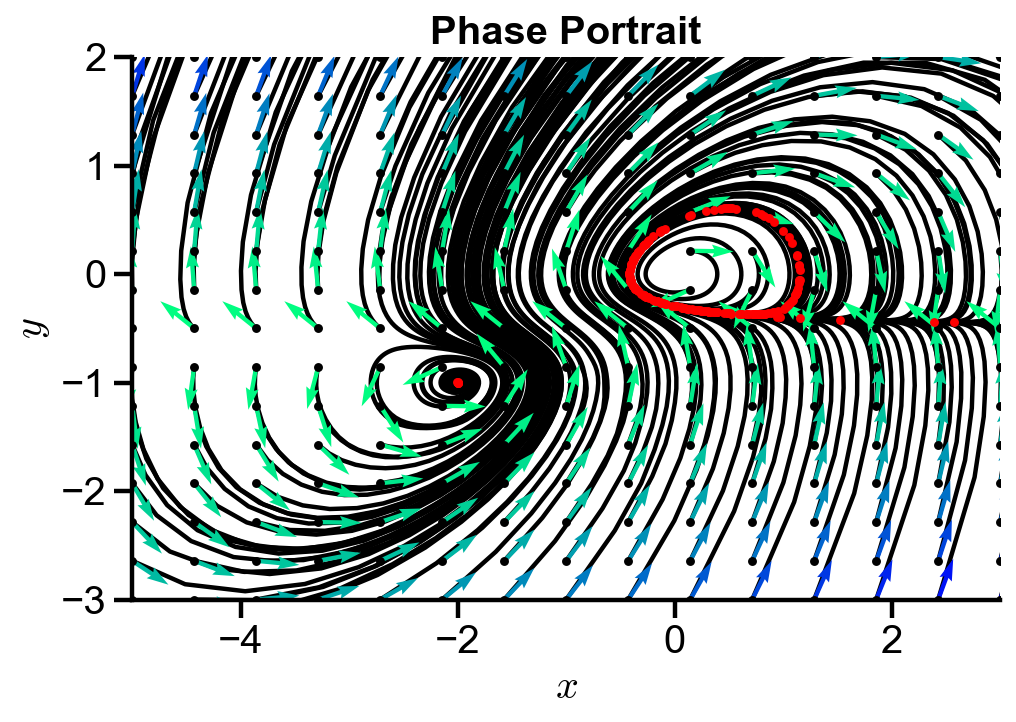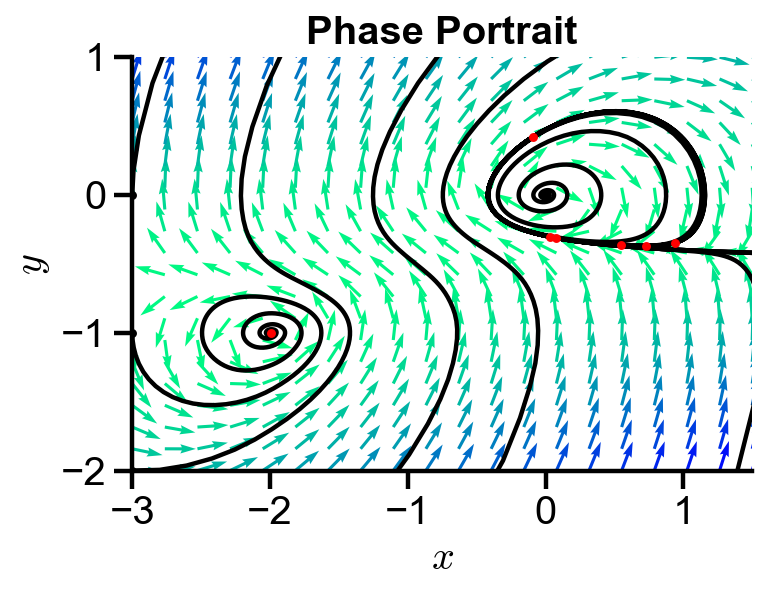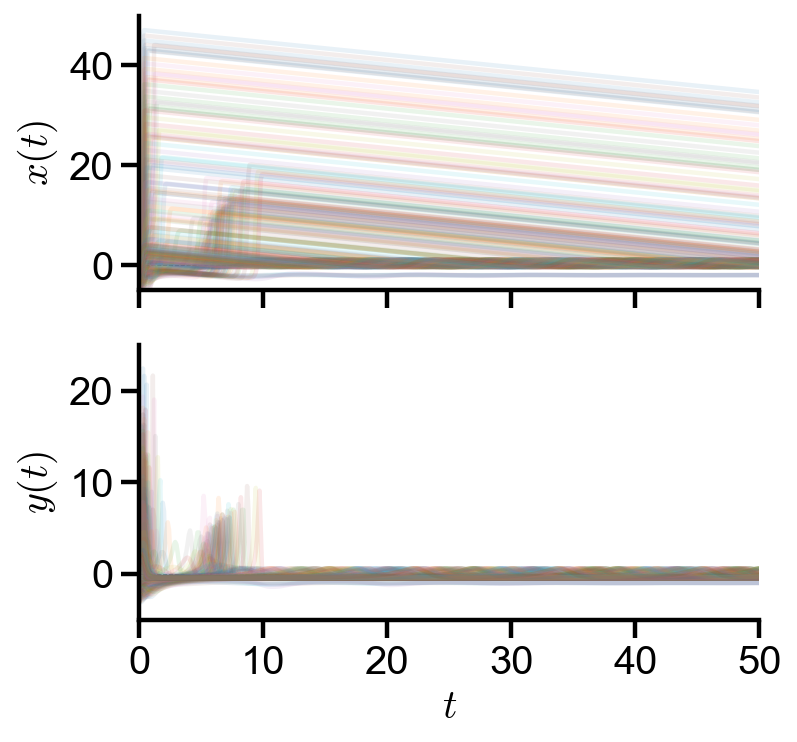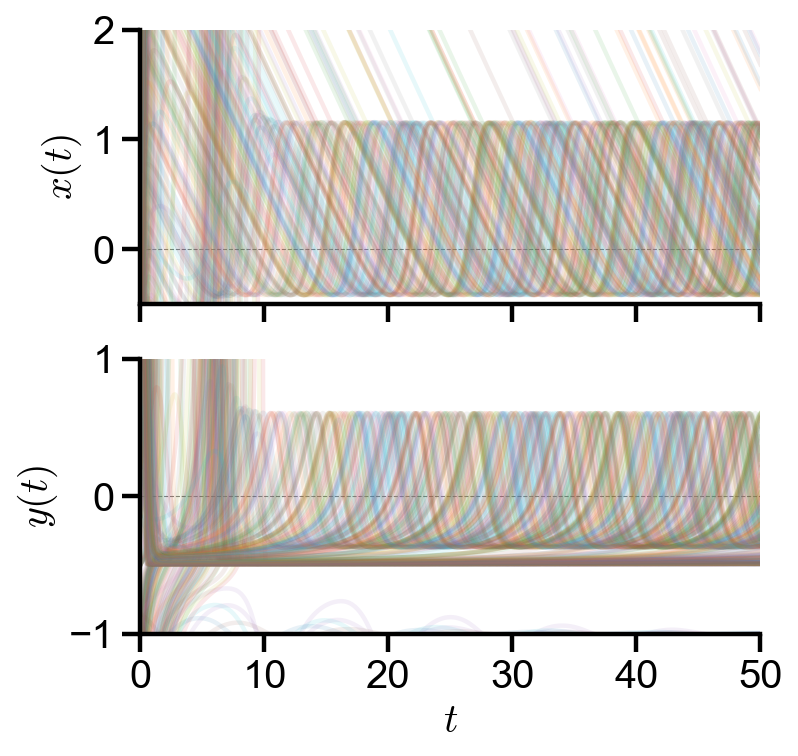Two-Eyed Monster#
Teng-Jui Lin
Content adapted from UW AMATH 301, Beginning Scientific Computing, in Spring 2020.
Phase portraits
“Two-eyed monster”
Two-eyed monster#
The system of ODEs
is called the “two-eyed monster.”
Static phase portrait#
Problem Statement. Consider the “two-eyed monster” system of ODEs.
(a) Plot the phase portrait of the ODE system with the initial conditions of the equidistant grid of points in
(b) Plot the phase portrait of the ODE system with the initial conditions (x, y) of
[0.01, 0], [-1, -3], [-3, -2], [-2, -3], [1, -3], [-3, 0], [-3, -1]
with
import numpy as np
import matplotlib.pyplot as plt
import scipy
from scipy import integrate
# quiver grid and initial conditions
xvec = np.linspace(-5, 3, 15)
yvec = np.linspace(-3, 2, 15)
X, Y = np.meshgrid(xvec, yvec)
initial_vals = np.meshgrid(xvec, yvec)
initial_vals = np.array([initial_vals[0].reshape(-1), initial_vals[1].reshape(-1)]).T
# time array
t_initial = 0
t_final = 100
dt = 0.1
t = np.arange(t_initial, t_final+dt/2, dt)
# ode system
dxdt = lambda x, y : y + y**2
dydt = lambda x, y : -0.5*x + 0.2*y - x*y + 1.2*y**2
ode_syst = lambda t, z : np.array([dxdt(*z), dydt(*z)])
def custom_plot_settings():
%config InlineBackend.figure_format = 'retina'
%matplotlib inline
plt.rcParams.update({
'font.family': 'Arial', # Times New Roman, Calibri
'font.weight': 'normal',
'mathtext.fontset': 'cm',
'font.size': 18,
'lines.linewidth': 2,
'axes.linewidth': 2,
'axes.spines.top': False,
'axes.spines.right': False,
'axes.titleweight': 'bold',
'axes.titlesize': 18,
'axes.labelweight': 'bold',
'xtick.major.size': 8,
'xtick.major.width': 2,
'ytick.major.size': 8,
'ytick.major.width': 2,
'figure.dpi': 80,
'savefig.dpi': 300,
'legend.framealpha': 1,
'legend.edgecolor': 'black',
'legend.fancybox': False,
'legend.fontsize': 14,
'animation.html': 'html5',
})
custom_plot_settings()
fig, ax = plt.subplots(figsize=(7, 7))
# slope field
scale = np.sqrt(dxdt(X, Y)**2 + dydt(X, Y)**2)
ax.quiver(X, Y, dxdt(X, Y)/scale, dydt(X, Y)/scale, scale, cmap='winter_r', scale=20, width=0.005) # regular
# plot settings
ax.set_xlim(-5, 3)
ax.set_ylim(-3, 2)
ax.set_xlabel('$x$')
ax.set_ylabel('$y$')
ax.set_title('Phase Portrait')
ax.set_aspect('equal')
for i in range(len(initial_vals)):
# ode soln
ode_soln = scipy.integrate.solve_ivp(ode_syst, [t_initial, t_final], initial_vals[i], t_eval=t)
# phase portrait
ax.plot(ode_soln.y[0], ode_soln.y[1], color='black', zorder=0.5)
ax.plot(ode_soln.y[0, -1], ode_soln.y[1, -1], '.', color='red', zorder=4)
ax.plot(*initial_vals[i], '.', color='black')

▲ The figure above shows the trajectories of a grid of initial conditions for the two-eyed monster system. Most of the initial conditions spiral into the two eyes and form loops around the eyes. The final state denoted in red forms a loop about the eye or is at the eye center.
# initial conditions [x0, y0]
initial_vals = np.array([[0.01, 0], [-1, -3], [-3, -2], [-2, -3], [1, -3], [-3, 0], [-3, -1]])
# quiver grid
xvec = np.linspace(-3, 1.5, 20)
yvec = np.linspace(-2, 1, 20)
X, Y = np.meshgrid(xvec, yvec)
fig, ax = plt.subplots(figsize=(5, 5))
# slope field
scale = np.sqrt(dxdt(X, Y)**2 + dydt(X, Y)**2)
ax.quiver(X, Y, dxdt(X, Y)/scale, dydt(X, Y)/scale, scale, cmap='winter_r', scale=20, width=0.005) # regular
# plot settings
ax.set_xlim(-3, 1.5)
ax.set_ylim(-2, 1)
ax.set_xlabel('$x$')
ax.set_ylabel('$y$')
ax.set_title('Phase Portrait')
ax.set_aspect('equal')
for i in range(len(initial_vals)):
# ode soln
ode_soln = scipy.integrate.solve_ivp(ode_syst, [t_initial, t_final], initial_vals[i], t_eval=t)
# phase portrait
ax.plot(ode_soln.y[0], ode_soln.y[1], color='black')
ax.plot(ode_soln.y[0, -1], ode_soln.y[1, -1], '.', color='red', zorder=4)
ax.plot(*initial_vals[i], '.', color='black')

▲ The figure above shows the trajectories of particular initial conditions for the two-eyed monster system. The trajectory spirals into the eyes or curve around the eyes.
Animated phase portrait#
Note on animation: for local reproducible results, download ffmpeg and add to path variable. For reproducible results online, use Google Colab and run the command below.
# Run the command in Google Colab for reproducible results online
# !apt install ffmpeg
# time array
t_initial = 0
t_final = 50
dt = 0.1
t = np.arange(t_initial, t_final+dt/2, dt)
t_len = len(t)
# ode system
dxdt = lambda x, y : y + y**2
dydt = lambda x, y : -0.5*x + 0.2*y - x*y + 1.2*y**2
ode_syst = lambda t, z : np.array([dxdt(*z), dydt(*z)])
# quiver grid and initial conditions
xvec = np.linspace(-5, 3, 15)
yvec = np.linspace(-3, 2, 15)
X, Y = np.meshgrid(xvec, yvec)
initial_vals = np.meshgrid(xvec, yvec)
initial_vals = np.array([initial_vals[0].reshape(-1), initial_vals[1].reshape(-1)]).T
# ode soln for grid of initial conditions
ode_solns = [0]*len(initial_vals)
for i in range(len(initial_vals)):
ode_solns[i] = scipy.integrate.solve_ivp(ode_syst, [t_initial, t_final], initial_vals[i], t_eval=t).y
ode_solns = np.array(ode_solns)
custom_plot_settings()
fig, axs = plt.subplots(2, 1, figsize=(5, 5), sharex=True)
axs[0].set_ylabel('$x(t)$')
axs[1].set_ylabel('$y(t)$')
axs[1].set_xlabel('$t$')
axs[0].set_ylim(-5, 50)
axs[1].set_ylim(-5, 25)
for i in range(len(initial_vals)):
axs[0].plot(t, ode_solns[i, 0], label='$x(t)$', alpha=0.1)
axs[1].plot(t, ode_solns[i, 1], label='$y(t)$', alpha=0.1)
for i in range(2):
axs[i].plot([t_initial, t_final], [0, 0], '--', color='grey', lw=0.5, zorder=0) # zero ref
axs[i].set_xlim(t_initial, t_final)

custom_plot_settings()
fig, axs = plt.subplots(2, 1, figsize=(5, 5), sharex=True)
axs[0].set_ylabel('$x(t)$')
axs[1].set_ylabel('$y(t)$')
axs[1].set_xlabel('$t$')
axs[0].set_ylim(-0.5, 2)
axs[1].set_ylim(-1, 1)
for i in range(len(initial_vals)):
axs[0].plot(t, ode_solns[i, 0], label='$x(t)$', alpha=0.1)
axs[1].plot(t, ode_solns[i, 1], label='$y(t)$', alpha=0.1)
for i in range(2):
axs[i].plot([t_initial, t_final], [0, 0], '--', color='grey', lw=0.5, zorder=0) # zero ref
axs[i].set_xlim(t_initial, t_final)

def make_animation(t_range=t_len, anim_time=4, fps=60, xmin=-5, xmax=3, ymin=-3, ymax=2):
'''
This function is notebook-specific and not meant to generalize to other settings.
Makes animation of time-dependent phase portrait.
Warning: Many parameters are taken from the global namespace. They need to be defined before use.
'''
# back to static plot and animations
custom_plot_settings()
# plot static portion
fig, ax = plt.subplots(figsize=(8/1.2, 5/1.2))
ax.set_xlim(xmin, xmax)
ax.set_ylim(ymin, ymax)
ax.set_xlabel('$x(t)$')
ax.set_ylabel('$y(t)$')
ax.set_aspect('equal')
plt.tight_layout()
# plot empty framework
points = np.zeros(len(initial_vals), dtype=object)
current_points = np.zeros(len(initial_vals), dtype=object)
for i in range(len(initial_vals)):
points[i], = ax.plot([], [], '.', color='black', alpha=0.05)
current_points[i], = ax.plot([], [], '.', color='red', alpha=0.2, zorder=10)
scale = np.sqrt(dxdt(X, Y)**2 + dydt(X, Y)**2)
qr = ax.quiver(X, Y, dxdt(X, Y)/scale, dydt(X, Y)/scale,
scale, cmap='winter_r', scale=20, width=0.005, zorder=3)
title = ax.set_title('')
def draw_frame(n):
'''
Commands to update parameters.
Here, the phase portrait data points and quiver each frame.
'''
time_points = round(t_range/frame_num)
frame_final_time = min(time_points*n+time_points, t_range-1) # avoid index out of range
for i in range(len(initial_vals)):
points[i].set_data(ode_solns[i, :, :frame_final_time])
current_points[i].set_data(*ode_solns[i, :, frame_final_time-1:frame_final_time])
scale = np.sqrt(dxdt(X, Y)**2 + dydt(X, Y)**2)
qr.set_UVC(dxdt(X, Y)/scale, dydt(X, Y)/scale, C=scale)
title.set_text(f't = {t[frame_final_time] :.3f}')
return fig,
# create animation of given time length
# note here we fit all the data points into the given animation time
from matplotlib import animation
frame_num = int(fps * anim_time)
anim = animation.FuncAnimation(fig, draw_frame, frames=frame_num, interval=1000/fps, blit=True)
plt.close() # disable showing initial frame
return anim
# convert animation to video (time-limiting step)
from IPython.display import HTML
anim = make_animation() # uses custom function above
HTML(anim.to_html5_video() + '<style>video{width: 400px !important; height: auto;}</style>')
# convert animation to video (time-limiting step)
from IPython.display import HTML
anim = make_animation(t_range=int(t_len/2)) # uses custom function above
HTML(anim.to_html5_video() + '<style>video{width: 400px !important; height: auto;}</style>')

